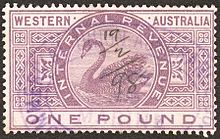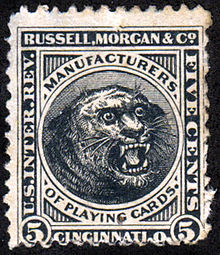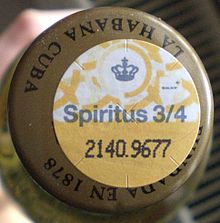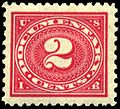- Revenue stamp
-
A revenue stamp, tax stamp or fiscal stamp is a (usually) adhesive label used to collect taxes or fees on documents, tobacco, alcoholic drinks, drugs and medicines, playing cards, hunting licenses, firearm registration, and many other things. Typically businesses purchase the stamps from the government, and attach them to taxed items as part of putting the items on sale, or in the case of documents, as part of filling out the form.
Revenue stamps often look very similar to postage stamps, and in some countries and time periods it has been possible to use postage stamps for revenue purposes.
Contents
Description
Revenue stamps are stamps used to collect taxes and fees. They are issued by Governments, national and local, and by official bodies of various kinds. They take many forms and may be gummed and ungummed, peforated or imperforate, printed or embossed, and of any size. In many countries, they are as detailed in their design as banknotes and they are often made from the same type of paper. The high value of many revenue stamps means that they may contain security devices to prevent counterfeiting.
The Revenue Society has defined revenue stamps as " ...stamps, whether impressed, adhesive or otherwise, issued by or on behalf of International, National or Local Governments, their Licensees or Agents, and indicate that a tax, duty or fee has been paid or prepaid or that permission has been granted." [1]
History
The use of revenue stamps goes back further than that of postage stamps (first used in 1840); the stamps of the Stamp Acts of the 18th century were revenues. Their use became widespread in the 19th century, partly inspired by the success of the postage stamp, and partly motivated by the desire to streamline government operations, the presence of a revenue stamp being an indication that the item in question had already paid the necessary fees. Revenue stamps have become less commonly seen in the 21st century, with the rise of computerization and the ability to use numbers to track payments accurately.
There are a great many kinds of revenue stamps in the world, and it is likely that some are still uncatalogued. Both national and local entities have issued them. In certain periods government have combined the uses of postage and revenue stamps, calling them "postal fiscals" or inscribing them "Postage and Revenue".
Methods of cancellation
Main article: Fiscal cancelWhile revenue stamps often resemble postage stamps, they are not normally intended for use on mail and therefore do not receive a postal cancellation. Some countries have issued stamps valid for both postage and revenue, but this practice is now rare. Many different methods have been used to cancel revenue stamps, including pen cancels, inked handstamps, perforating, embossing, hole punching or simply tearing.
Collecting
Revenue stamps were once widely collected by philatelists and given the same status as postage stamps in stamp catalogs and at exhibitions. After World War One, however, they declined in popularity, possibly due to being excluded from catalogues as the number of postage stamps issued rose rapidly and crowded revenues out. Recently they have become popular again and they now have their own FIP (Fédération Internationale de Philatélie) Commission and are an approved category in FIP endorsed stamp exhibitions.[2]
Many catalogs have been issued by specialist publishers and dealers but it is true to say that revenue stamps still do not feature in the most popular catalogs, for instance the standard Scott, Stanley Gibbons and Michel catalogs, unless they are both revenue and postage stamps. The Scott specialised United States catalogue does feature US revenue stamps.
Some types of revenue stamps
Court fees
One of the earliest uses of revenue stamps was to pay Court Fees. Stamps were used in the Indian feudal states as early as 1797, almost 50 years before the first postal stamps.[3]
Although India is only one of several countries that have used tax stamps on legal documents, it was one of the most prolific users. The practice is almost entirely stopped now, partly due to the prevalence of forgeries which cost the issuing government revenue.[4]
Documents
The tax on documents, also commonly known as stamp duty, is one of the oldest uses of revenue stamps. Governments would enforce the payment of the tax by making unstamped documents unenforcable in court. The tax would apply to contracts, tenancy agreements, wills etc.
Tobacco and alcohol
In many countries, tobacco and alcohol are taxed by the use of excise stamps. For instance, the producer may buy stamps from the government which are then affixed to each bottle of alcohol or packet of cigarettes to show that tax has been paid. Often the stamp will be fixed across a seal so that on opening the pack or bottle the stamp is destroyed.[5]
Gallery
-
Ottoman revenue stamp for the construction of Hejaz railway
See also
- Impressed duty stamp
- Stamped paper
References
- ^ Home. The Revenue Society, 2011. Retrieved 1 October 2011.
- ^ FIP REVENUE COMMISSION Fédération Internationale de Philatélie 2011. Retrieved 1 October 2011.
- ^ Court Fee and Revenue Stamps of the Princely States of India.
- ^ Court fee stamp racket busted, The Hindu, Sept. 10, 2003.
- ^ UK Duty Stamps Scheme. H.M. Revenue & Customs, May 2010. Retrieved 1 October 2011. Archived here.
Further reading
- Catalogues by John Barefoot.
- Catalogues by Alfred Forbin.
- Catalogues by Walter Morley.
- Akerman, Clive. The Presentation of Revenue Stamps: Taxes and Duties in South America. New edition. The Revenue Society of Great Britain, 2002.
Revenue philatelic societies
- American Revenue Association
- Fiscal Philatelic Society
- The Revenue Society
- The State Revenue Society
External links
Categories:- Revenue stamps
- Cinderella stamps
- Philatelic terminology
- Taxation
Wikimedia Foundation. 2010.










